Establishing Formal and Informal Communication Channels
VerifiedAdded on 2023/06/03
|8
|1795
|283
AI Summary
This article discusses the two types of communication in organizations: formal and informal. It explains the channels of communication, their benefits and uses, and how effective communication can improve relationships, productivity and innovation.
Contribute Materials
Your contribution can guide someone’s learning journey. Share your
documents today.
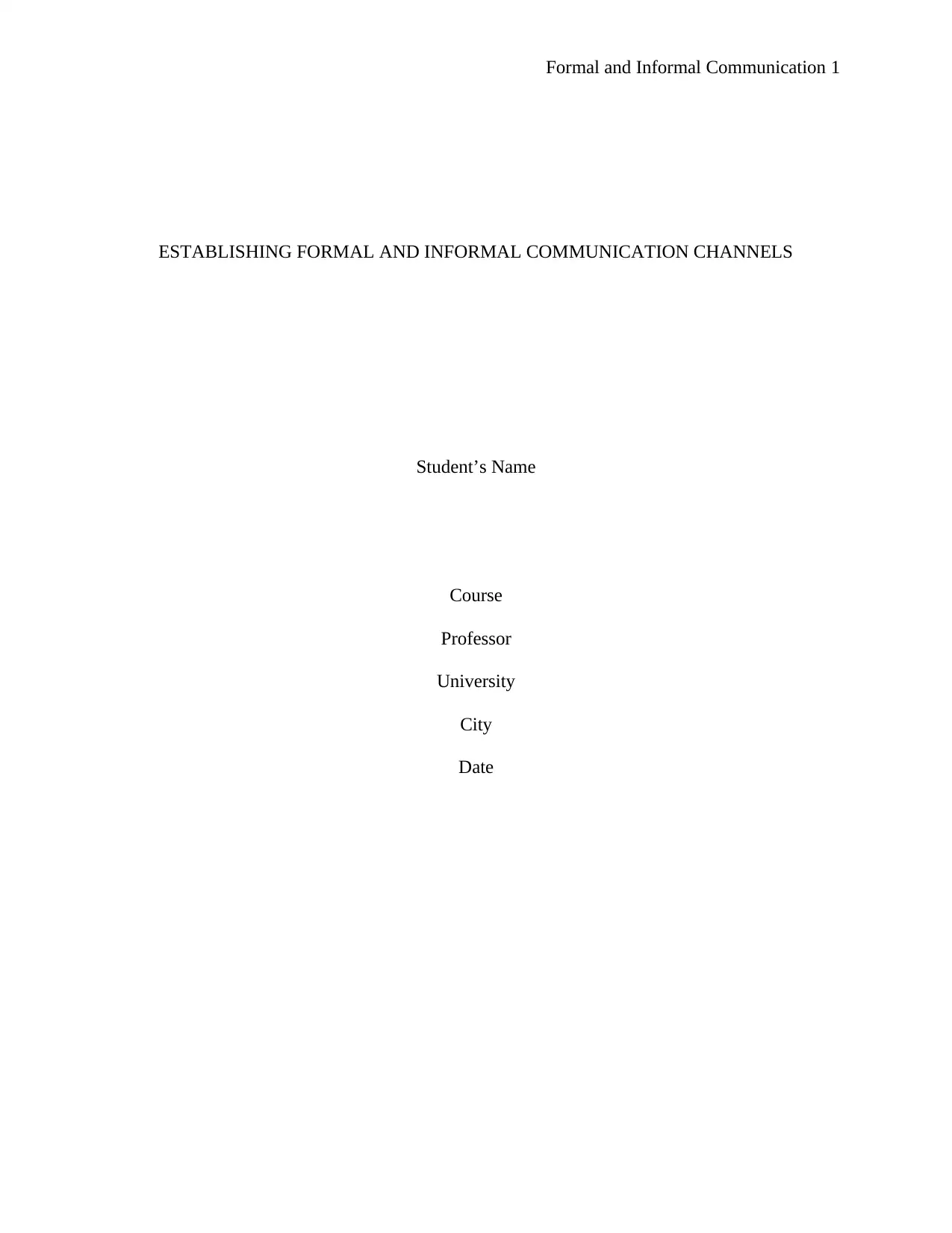
Formal and Informal Communication 1
ESTABLISHING FORMAL AND INFORMAL COMMUNICATION CHANNELS
Student’s Name
Course
Professor
University
City
Date
ESTABLISHING FORMAL AND INFORMAL COMMUNICATION CHANNELS
Student’s Name
Course
Professor
University
City
Date
Secure Best Marks with AI Grader
Need help grading? Try our AI Grader for instant feedback on your assignments.
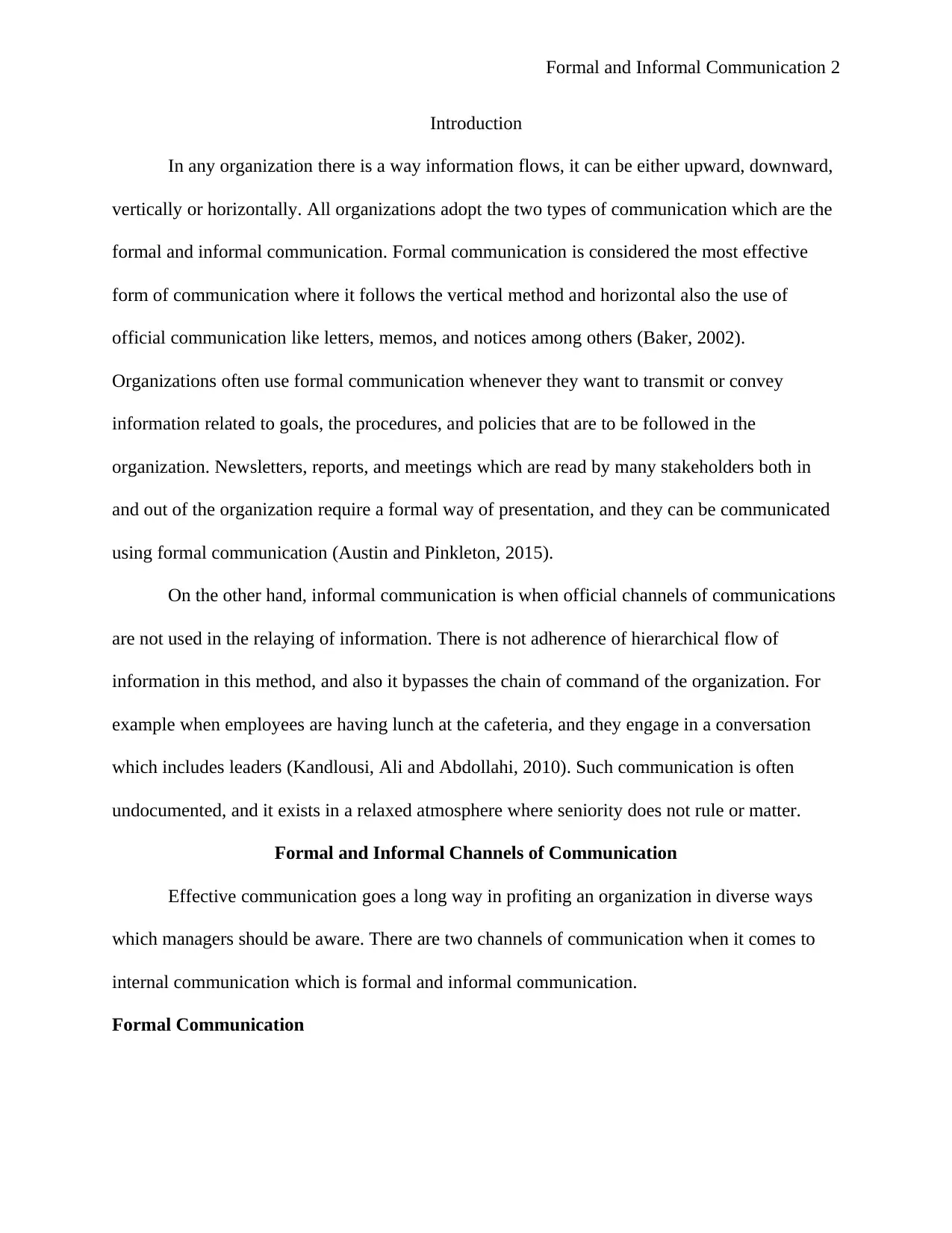
Formal and Informal Communication 2
Introduction
In any organization there is a way information flows, it can be either upward, downward,
vertically or horizontally. All organizations adopt the two types of communication which are the
formal and informal communication. Formal communication is considered the most effective
form of communication where it follows the vertical method and horizontal also the use of
official communication like letters, memos, and notices among others (Baker, 2002).
Organizations often use formal communication whenever they want to transmit or convey
information related to goals, the procedures, and policies that are to be followed in the
organization. Newsletters, reports, and meetings which are read by many stakeholders both in
and out of the organization require a formal way of presentation, and they can be communicated
using formal communication (Austin and Pinkleton, 2015).
On the other hand, informal communication is when official channels of communications
are not used in the relaying of information. There is not adherence of hierarchical flow of
information in this method, and also it bypasses the chain of command of the organization. For
example when employees are having lunch at the cafeteria, and they engage in a conversation
which includes leaders (Kandlousi, Ali and Abdollahi, 2010). Such communication is often
undocumented, and it exists in a relaxed atmosphere where seniority does not rule or matter.
Formal and Informal Channels of Communication
Effective communication goes a long way in profiting an organization in diverse ways
which managers should be aware. There are two channels of communication when it comes to
internal communication which is formal and informal communication.
Formal Communication
Introduction
In any organization there is a way information flows, it can be either upward, downward,
vertically or horizontally. All organizations adopt the two types of communication which are the
formal and informal communication. Formal communication is considered the most effective
form of communication where it follows the vertical method and horizontal also the use of
official communication like letters, memos, and notices among others (Baker, 2002).
Organizations often use formal communication whenever they want to transmit or convey
information related to goals, the procedures, and policies that are to be followed in the
organization. Newsletters, reports, and meetings which are read by many stakeholders both in
and out of the organization require a formal way of presentation, and they can be communicated
using formal communication (Austin and Pinkleton, 2015).
On the other hand, informal communication is when official channels of communications
are not used in the relaying of information. There is not adherence of hierarchical flow of
information in this method, and also it bypasses the chain of command of the organization. For
example when employees are having lunch at the cafeteria, and they engage in a conversation
which includes leaders (Kandlousi, Ali and Abdollahi, 2010). Such communication is often
undocumented, and it exists in a relaxed atmosphere where seniority does not rule or matter.
Formal and Informal Channels of Communication
Effective communication goes a long way in profiting an organization in diverse ways
which managers should be aware. There are two channels of communication when it comes to
internal communication which is formal and informal communication.
Formal Communication
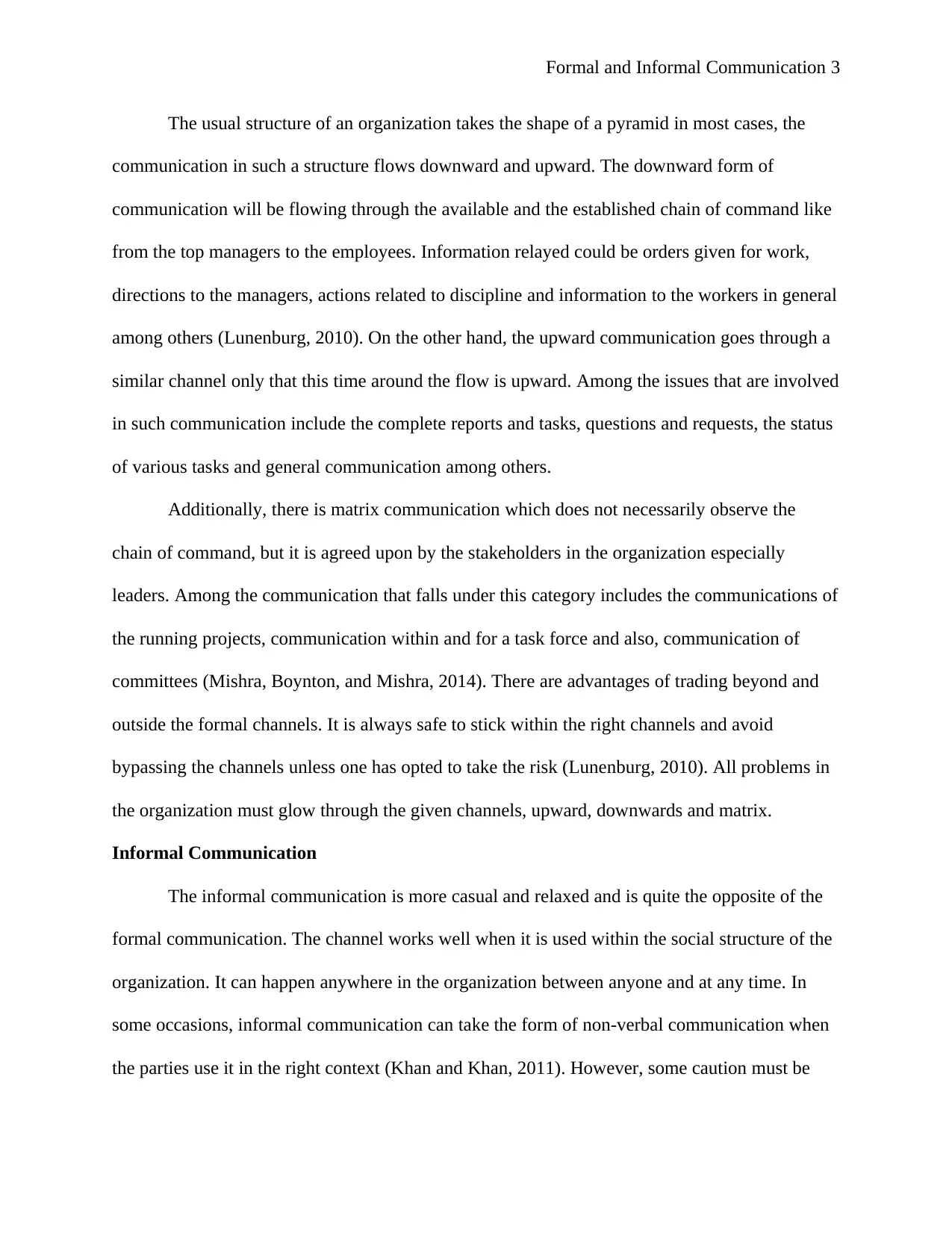
Formal and Informal Communication 3
The usual structure of an organization takes the shape of a pyramid in most cases, the
communication in such a structure flows downward and upward. The downward form of
communication will be flowing through the available and the established chain of command like
from the top managers to the employees. Information relayed could be orders given for work,
directions to the managers, actions related to discipline and information to the workers in general
among others (Lunenburg, 2010). On the other hand, the upward communication goes through a
similar channel only that this time around the flow is upward. Among the issues that are involved
in such communication include the complete reports and tasks, questions and requests, the status
of various tasks and general communication among others.
Additionally, there is matrix communication which does not necessarily observe the
chain of command, but it is agreed upon by the stakeholders in the organization especially
leaders. Among the communication that falls under this category includes the communications of
the running projects, communication within and for a task force and also, communication of
committees (Mishra, Boynton, and Mishra, 2014). There are advantages of trading beyond and
outside the formal channels. It is always safe to stick within the right channels and avoid
bypassing the channels unless one has opted to take the risk (Lunenburg, 2010). All problems in
the organization must glow through the given channels, upward, downwards and matrix.
Informal Communication
The informal communication is more casual and relaxed and is quite the opposite of the
formal communication. The channel works well when it is used within the social structure of the
organization. It can happen anywhere in the organization between anyone and at any time. In
some occasions, informal communication can take the form of non-verbal communication when
the parties use it in the right context (Khan and Khan, 2011). However, some caution must be
The usual structure of an organization takes the shape of a pyramid in most cases, the
communication in such a structure flows downward and upward. The downward form of
communication will be flowing through the available and the established chain of command like
from the top managers to the employees. Information relayed could be orders given for work,
directions to the managers, actions related to discipline and information to the workers in general
among others (Lunenburg, 2010). On the other hand, the upward communication goes through a
similar channel only that this time around the flow is upward. Among the issues that are involved
in such communication include the complete reports and tasks, questions and requests, the status
of various tasks and general communication among others.
Additionally, there is matrix communication which does not necessarily observe the
chain of command, but it is agreed upon by the stakeholders in the organization especially
leaders. Among the communication that falls under this category includes the communications of
the running projects, communication within and for a task force and also, communication of
committees (Mishra, Boynton, and Mishra, 2014). There are advantages of trading beyond and
outside the formal channels. It is always safe to stick within the right channels and avoid
bypassing the channels unless one has opted to take the risk (Lunenburg, 2010). All problems in
the organization must glow through the given channels, upward, downwards and matrix.
Informal Communication
The informal communication is more casual and relaxed and is quite the opposite of the
formal communication. The channel works well when it is used within the social structure of the
organization. It can happen anywhere in the organization between anyone and at any time. In
some occasions, informal communication can take the form of non-verbal communication when
the parties use it in the right context (Khan and Khan, 2011). However, some caution must be
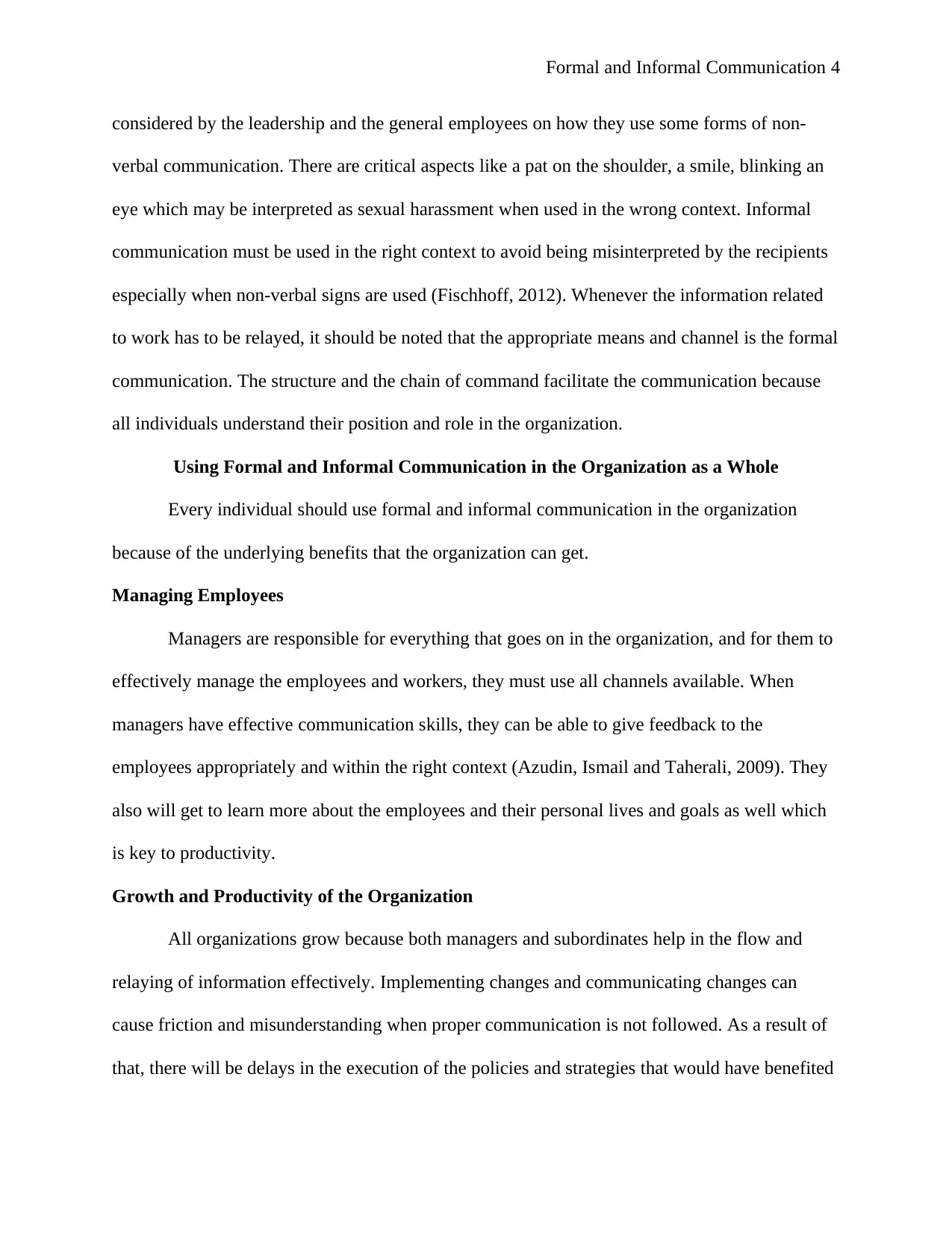
Formal and Informal Communication 4
considered by the leadership and the general employees on how they use some forms of non-
verbal communication. There are critical aspects like a pat on the shoulder, a smile, blinking an
eye which may be interpreted as sexual harassment when used in the wrong context. Informal
communication must be used in the right context to avoid being misinterpreted by the recipients
especially when non-verbal signs are used (Fischhoff, 2012). Whenever the information related
to work has to be relayed, it should be noted that the appropriate means and channel is the formal
communication. The structure and the chain of command facilitate the communication because
all individuals understand their position and role in the organization.
Using Formal and Informal Communication in the Organization as a Whole
Every individual should use formal and informal communication in the organization
because of the underlying benefits that the organization can get.
Managing Employees
Managers are responsible for everything that goes on in the organization, and for them to
effectively manage the employees and workers, they must use all channels available. When
managers have effective communication skills, they can be able to give feedback to the
employees appropriately and within the right context (Azudin, Ismail and Taherali, 2009). They
also will get to learn more about the employees and their personal lives and goals as well which
is key to productivity.
Growth and Productivity of the Organization
All organizations grow because both managers and subordinates help in the flow and
relaying of information effectively. Implementing changes and communicating changes can
cause friction and misunderstanding when proper communication is not followed. As a result of
that, there will be delays in the execution of the policies and strategies that would have benefited
considered by the leadership and the general employees on how they use some forms of non-
verbal communication. There are critical aspects like a pat on the shoulder, a smile, blinking an
eye which may be interpreted as sexual harassment when used in the wrong context. Informal
communication must be used in the right context to avoid being misinterpreted by the recipients
especially when non-verbal signs are used (Fischhoff, 2012). Whenever the information related
to work has to be relayed, it should be noted that the appropriate means and channel is the formal
communication. The structure and the chain of command facilitate the communication because
all individuals understand their position and role in the organization.
Using Formal and Informal Communication in the Organization as a Whole
Every individual should use formal and informal communication in the organization
because of the underlying benefits that the organization can get.
Managing Employees
Managers are responsible for everything that goes on in the organization, and for them to
effectively manage the employees and workers, they must use all channels available. When
managers have effective communication skills, they can be able to give feedback to the
employees appropriately and within the right context (Azudin, Ismail and Taherali, 2009). They
also will get to learn more about the employees and their personal lives and goals as well which
is key to productivity.
Growth and Productivity of the Organization
All organizations grow because both managers and subordinates help in the flow and
relaying of information effectively. Implementing changes and communicating changes can
cause friction and misunderstanding when proper communication is not followed. As a result of
that, there will be delays in the execution of the policies and strategies that would have benefited
Secure Best Marks with AI Grader
Need help grading? Try our AI Grader for instant feedback on your assignments.
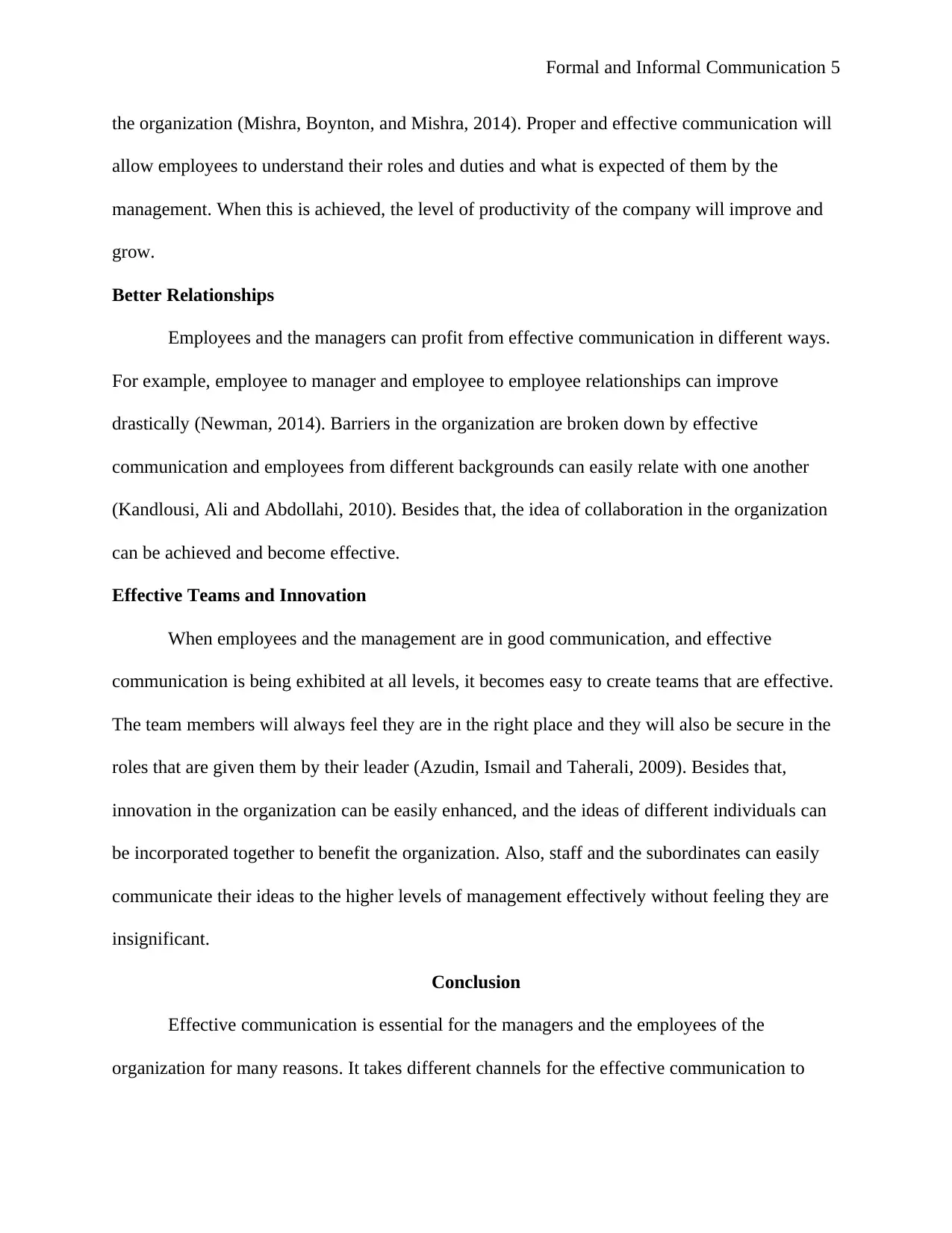
Formal and Informal Communication 5
the organization (Mishra, Boynton, and Mishra, 2014). Proper and effective communication will
allow employees to understand their roles and duties and what is expected of them by the
management. When this is achieved, the level of productivity of the company will improve and
grow.
Better Relationships
Employees and the managers can profit from effective communication in different ways.
For example, employee to manager and employee to employee relationships can improve
drastically (Newman, 2014). Barriers in the organization are broken down by effective
communication and employees from different backgrounds can easily relate with one another
(Kandlousi, Ali and Abdollahi, 2010). Besides that, the idea of collaboration in the organization
can be achieved and become effective.
Effective Teams and Innovation
When employees and the management are in good communication, and effective
communication is being exhibited at all levels, it becomes easy to create teams that are effective.
The team members will always feel they are in the right place and they will also be secure in the
roles that are given them by their leader (Azudin, Ismail and Taherali, 2009). Besides that,
innovation in the organization can be easily enhanced, and the ideas of different individuals can
be incorporated together to benefit the organization. Also, staff and the subordinates can easily
communicate their ideas to the higher levels of management effectively without feeling they are
insignificant.
Conclusion
Effective communication is essential for the managers and the employees of the
organization for many reasons. It takes different channels for the effective communication to
the organization (Mishra, Boynton, and Mishra, 2014). Proper and effective communication will
allow employees to understand their roles and duties and what is expected of them by the
management. When this is achieved, the level of productivity of the company will improve and
grow.
Better Relationships
Employees and the managers can profit from effective communication in different ways.
For example, employee to manager and employee to employee relationships can improve
drastically (Newman, 2014). Barriers in the organization are broken down by effective
communication and employees from different backgrounds can easily relate with one another
(Kandlousi, Ali and Abdollahi, 2010). Besides that, the idea of collaboration in the organization
can be achieved and become effective.
Effective Teams and Innovation
When employees and the management are in good communication, and effective
communication is being exhibited at all levels, it becomes easy to create teams that are effective.
The team members will always feel they are in the right place and they will also be secure in the
roles that are given them by their leader (Azudin, Ismail and Taherali, 2009). Besides that,
innovation in the organization can be easily enhanced, and the ideas of different individuals can
be incorporated together to benefit the organization. Also, staff and the subordinates can easily
communicate their ideas to the higher levels of management effectively without feeling they are
insignificant.
Conclusion
Effective communication is essential for the managers and the employees of the
organization for many reasons. It takes different channels for the effective communication to
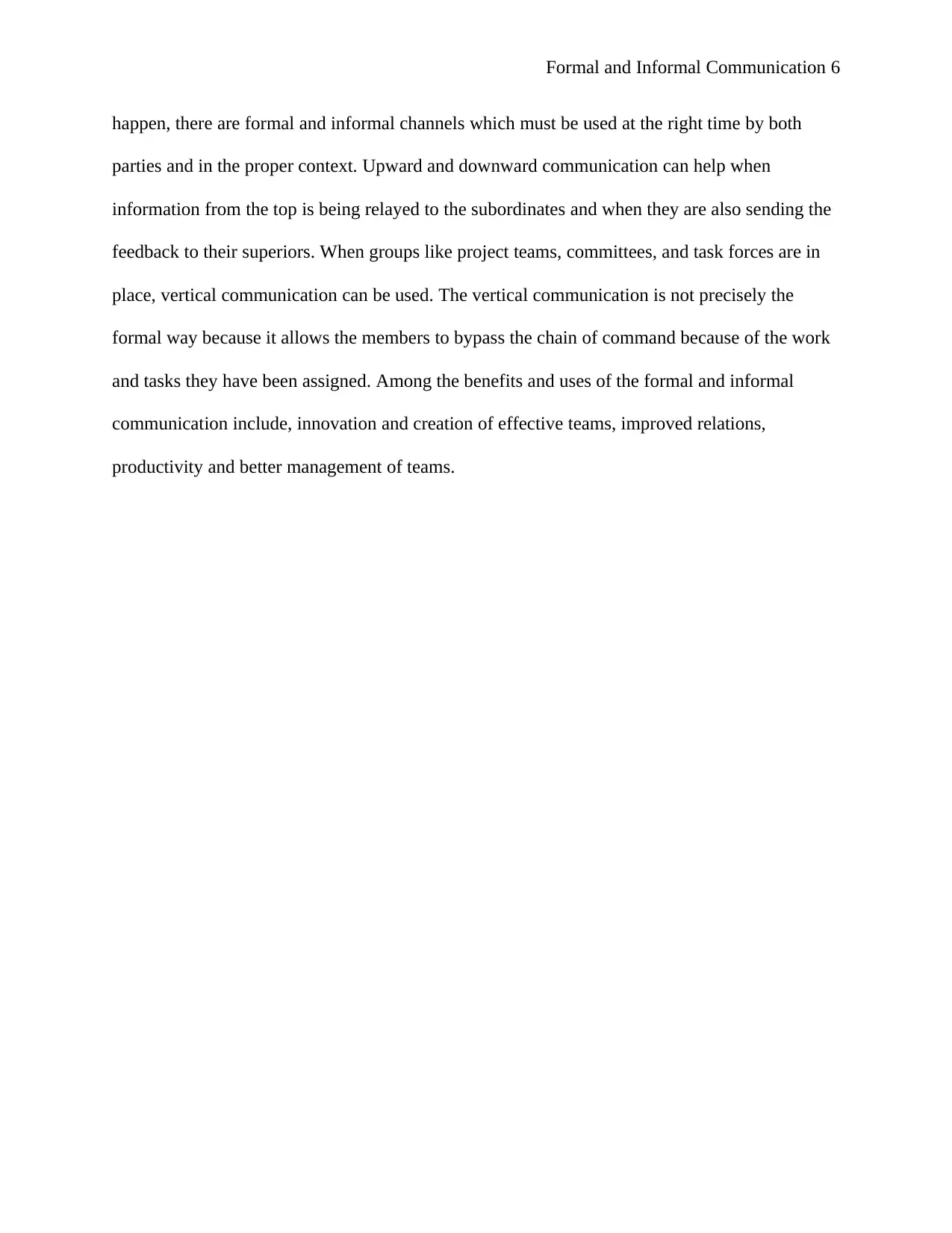
Formal and Informal Communication 6
happen, there are formal and informal channels which must be used at the right time by both
parties and in the proper context. Upward and downward communication can help when
information from the top is being relayed to the subordinates and when they are also sending the
feedback to their superiors. When groups like project teams, committees, and task forces are in
place, vertical communication can be used. The vertical communication is not precisely the
formal way because it allows the members to bypass the chain of command because of the work
and tasks they have been assigned. Among the benefits and uses of the formal and informal
communication include, innovation and creation of effective teams, improved relations,
productivity and better management of teams.
happen, there are formal and informal channels which must be used at the right time by both
parties and in the proper context. Upward and downward communication can help when
information from the top is being relayed to the subordinates and when they are also sending the
feedback to their superiors. When groups like project teams, committees, and task forces are in
place, vertical communication can be used. The vertical communication is not precisely the
formal way because it allows the members to bypass the chain of command because of the work
and tasks they have been assigned. Among the benefits and uses of the formal and informal
communication include, innovation and creation of effective teams, improved relations,
productivity and better management of teams.
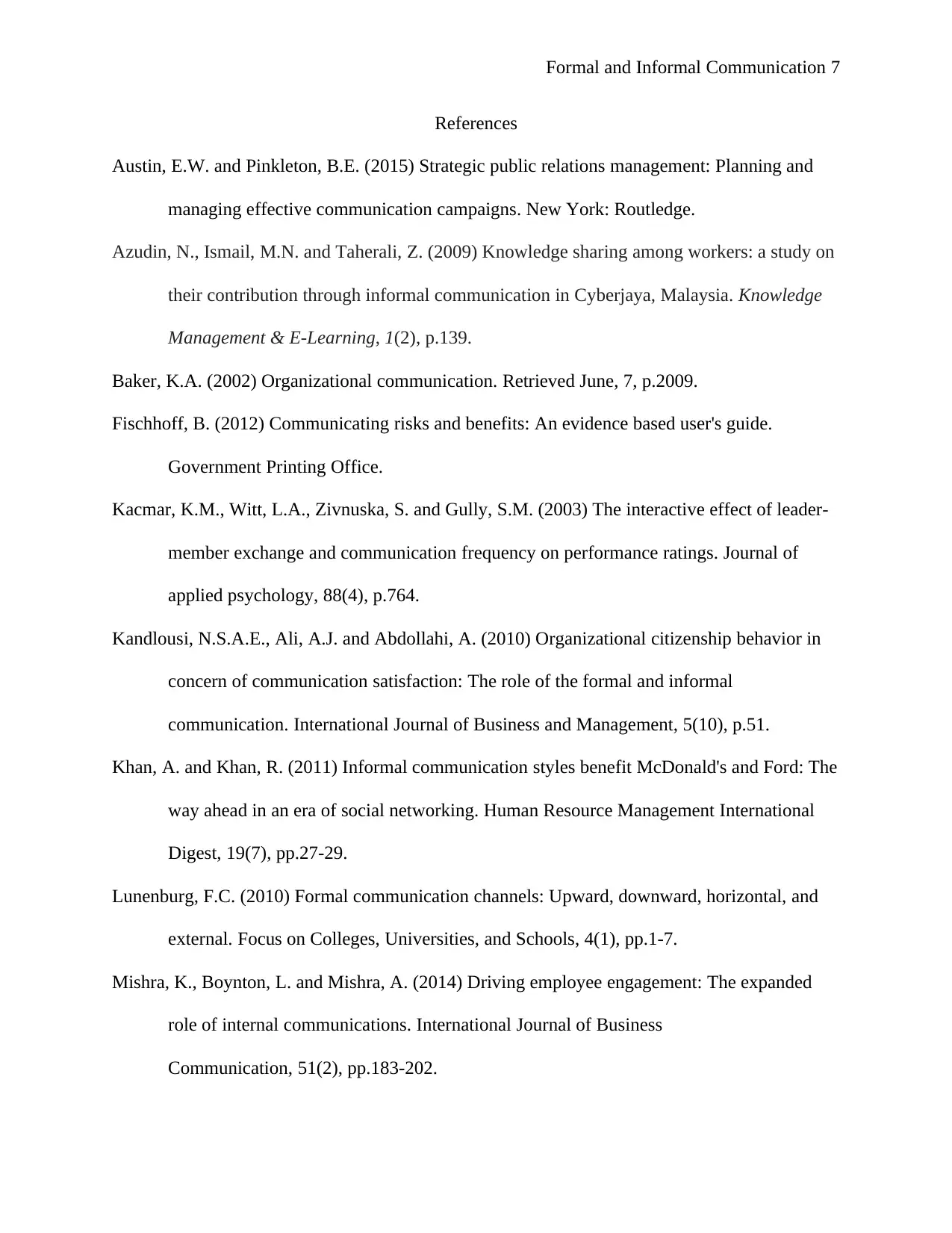
Formal and Informal Communication 7
References
Austin, E.W. and Pinkleton, B.E. (2015) Strategic public relations management: Planning and
managing effective communication campaigns. New York: Routledge.
Azudin, N., Ismail, M.N. and Taherali, Z. (2009) Knowledge sharing among workers: a study on
their contribution through informal communication in Cyberjaya, Malaysia. Knowledge
Management & E-Learning, 1(2), p.139.
Baker, K.A. (2002) Organizational communication. Retrieved June, 7, p.2009.
Fischhoff, B. (2012) Communicating risks and benefits: An evidence based user's guide.
Government Printing Office.
Kacmar, K.M., Witt, L.A., Zivnuska, S. and Gully, S.M. (2003) The interactive effect of leader-
member exchange and communication frequency on performance ratings. Journal of
applied psychology, 88(4), p.764.
Kandlousi, N.S.A.E., Ali, A.J. and Abdollahi, A. (2010) Organizational citizenship behavior in
concern of communication satisfaction: The role of the formal and informal
communication. International Journal of Business and Management, 5(10), p.51.
Khan, A. and Khan, R. (2011) Informal communication styles benefit McDonald's and Ford: The
way ahead in an era of social networking. Human Resource Management International
Digest, 19(7), pp.27-29.
Lunenburg, F.C. (2010) Formal communication channels: Upward, downward, horizontal, and
external. Focus on Colleges, Universities, and Schools, 4(1), pp.1-7.
Mishra, K., Boynton, L. and Mishra, A. (2014) Driving employee engagement: The expanded
role of internal communications. International Journal of Business
Communication, 51(2), pp.183-202.
References
Austin, E.W. and Pinkleton, B.E. (2015) Strategic public relations management: Planning and
managing effective communication campaigns. New York: Routledge.
Azudin, N., Ismail, M.N. and Taherali, Z. (2009) Knowledge sharing among workers: a study on
their contribution through informal communication in Cyberjaya, Malaysia. Knowledge
Management & E-Learning, 1(2), p.139.
Baker, K.A. (2002) Organizational communication. Retrieved June, 7, p.2009.
Fischhoff, B. (2012) Communicating risks and benefits: An evidence based user's guide.
Government Printing Office.
Kacmar, K.M., Witt, L.A., Zivnuska, S. and Gully, S.M. (2003) The interactive effect of leader-
member exchange and communication frequency on performance ratings. Journal of
applied psychology, 88(4), p.764.
Kandlousi, N.S.A.E., Ali, A.J. and Abdollahi, A. (2010) Organizational citizenship behavior in
concern of communication satisfaction: The role of the formal and informal
communication. International Journal of Business and Management, 5(10), p.51.
Khan, A. and Khan, R. (2011) Informal communication styles benefit McDonald's and Ford: The
way ahead in an era of social networking. Human Resource Management International
Digest, 19(7), pp.27-29.
Lunenburg, F.C. (2010) Formal communication channels: Upward, downward, horizontal, and
external. Focus on Colleges, Universities, and Schools, 4(1), pp.1-7.
Mishra, K., Boynton, L. and Mishra, A. (2014) Driving employee engagement: The expanded
role of internal communications. International Journal of Business
Communication, 51(2), pp.183-202.
Paraphrase This Document
Need a fresh take? Get an instant paraphrase of this document with our AI Paraphraser
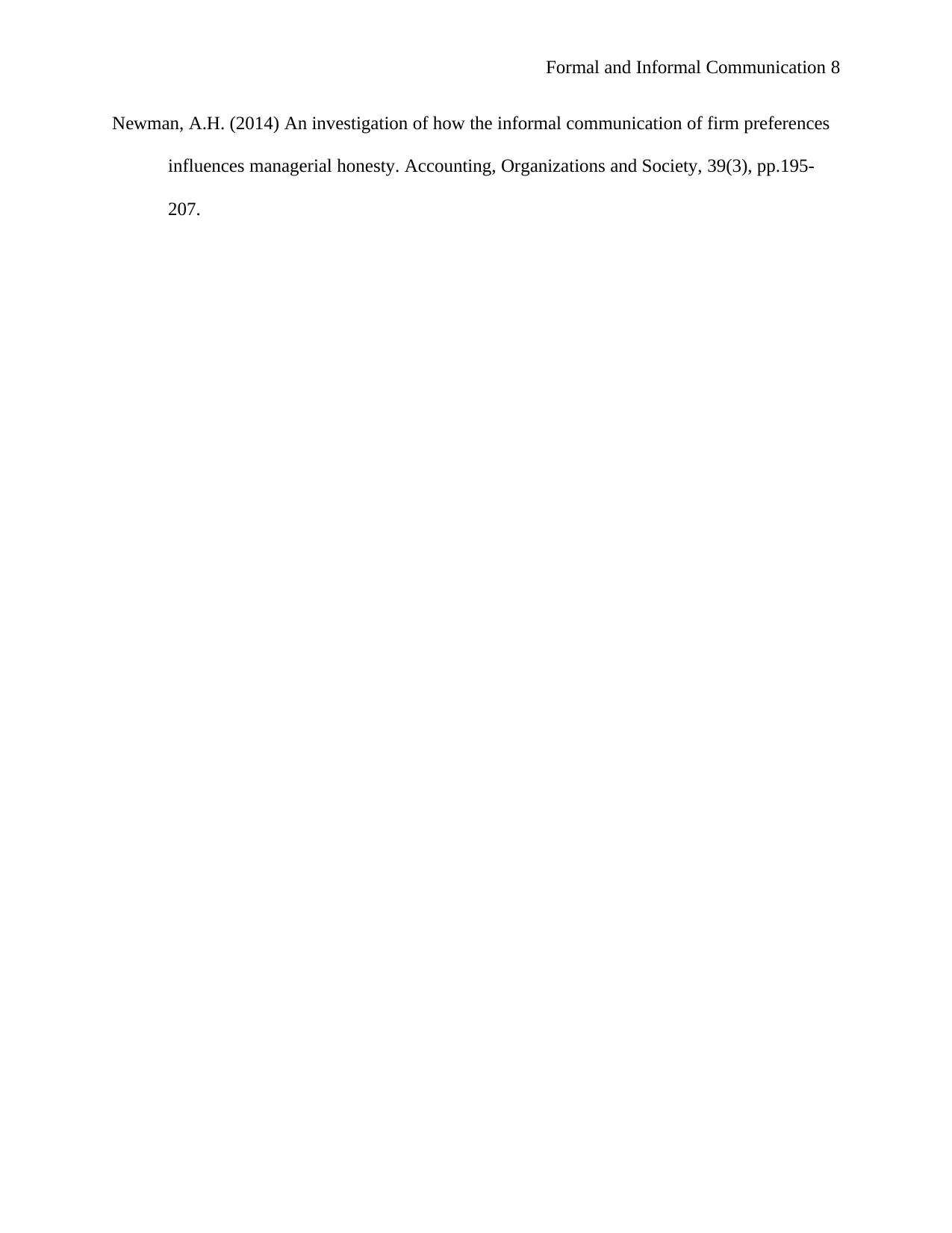
Formal and Informal Communication 8
Newman, A.H. (2014) An investigation of how the informal communication of firm preferences
influences managerial honesty. Accounting, Organizations and Society, 39(3), pp.195-
207.
Newman, A.H. (2014) An investigation of how the informal communication of firm preferences
influences managerial honesty. Accounting, Organizations and Society, 39(3), pp.195-
207.
1 out of 8
Related Documents
Your All-in-One AI-Powered Toolkit for Academic Success.
+13062052269
info@desklib.com
Available 24*7 on WhatsApp / Email
![[object Object]](/_next/static/media/star-bottom.7253800d.svg)
Unlock your academic potential
© 2024 | Zucol Services PVT LTD | All rights reserved.


